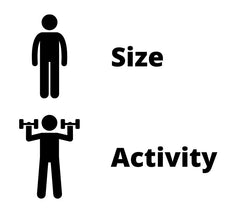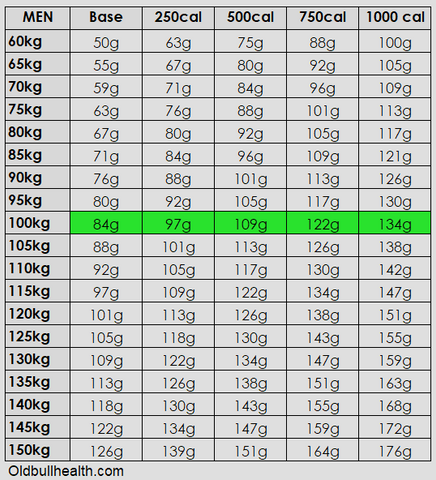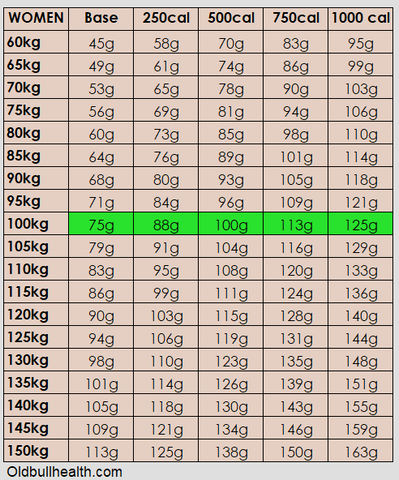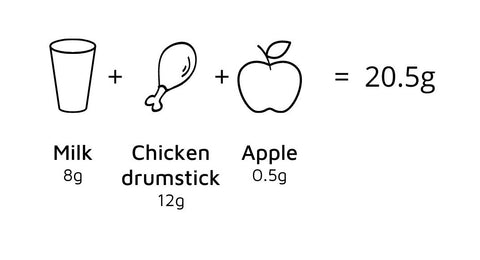Daily protein intake for Men
Unique Protein Intake Chart for Men.
Old Bull protein powder, as with most powders, includes a 30g scoop. However, not all powders have the same % protein; for example, an isolate (WPI) would have a higher % than a Concentrate (WPC). Isolate protein powders have a higher protein % and generally cost more than a concentrate or Casein protein.
Step 1: Preparation
Check out your protein's percentage protein versus total serve to be clear on intake.
Next:
- How many protein shakes should can I have in a day?
- What should my daily protein intake be?
- Does protein intake differ by age?
- Does protein intake differ by body shape and weight?
- Do I need more protein if I'm training?
The above are all great questions, and there is little clear guidance out there.
Protein drivers
See our Getting Started with Protein Guide here if this is new to you first.
The ideal number of protein shakes should be determined by size, diet, and level of activity.
As a general rule, the bigger you are and the more active you are, the more protein your body needs. Amounts will differ between men and women, mainly due to size and muscle mass. So key drivers include:

Australian recommended guidelines.
The Australian recommended guidelines are an EAR* of 0.84g/kg for men and 0.75g/kg for women. More in our Protein Users Guide.
There is, however, evidence to show that men over 53 years old have a 25% higher protein requirement for maintenance, and this again increases at 70 years of age.
* EAR = An intake value that is estimated to meet the requirements of half the healthy individuals in the group, so really a guideline.
The above however is general, a one-size-fits-all and does not consider varying body shapes and sizes, sex, or activity levels! So, read more.
Step 2: Determine daily requirements
1. Move down the left-hand column until you get to the weight closest to your weight.
2. Then, use the "Base" column, or if you're active and work out, move across to the right from your weight until you get to the column that best represents the calories you burn from exercise or activity on any particular day. (Calories totals are shown at the top of each column).
3. Where the Weight row and the Base or Calorie columns intersect is the suggested daily protein intake in grams. (See assumptions below).
PROTEIN DAILY INTAKE CHART FOR MEN

PROTEIN DAILY INTAKE CHART FOR WOMEN

Assumptions:
- 1g of protein is 4 calories, and the protein content from calories is 20%. (The average is based on various research papers.) Australia and New Zealand nutrient reference values and guidelines quote a minimum of 10% and a maximum of 35%.
- Body composition is not taken into account in the above or individual circumstances or health conditions.
But keep in mind.
Step 3: Consider daily nutrition.
Much of what we eat already includes protein (See the images below). If you don't consume sufficient protein in your diet, you may have a protein gap.
This can be exacerbated as we age. We might eat less to maintain a certain weight or avoid foods rich in protein.
We may be reducing our protein intake without even knowing.
Protein shakes are a great way to fill this gap. They can help you get your intake on track, and having a shake a couple of hours before or after your meal can improve absorption.
Example protein intake.

Step 4. Calculate protein requirement.
OK, so consider your average daily diet: milk, meat, poultry, fish, vegetables, fruit, etc, and the total amount of protein in grams consumed as part of that diet. Most of us have a routine, so this should be easy. (Use an app like MyFitnessPal to help if required.)
Then use the tables above to work out a guideline for your protein requirement.

For example, my numbers are as follows:
I am 90 KG and would burn, on average, an additional 500 calories a day from walking or short runs at a minimum.
My base need is 76 g and with my exercise, around 101 g. I know a large flat white is around 8 g, and my meals would have around another 50 g. On an average day, I would have a shake in the morning and then after exercise, so around 50 g of protein from protein powder, making it around 108 g in total.
Perfect for me to help retain and gain muscle mass. A good protein also helps manage appetite through satiety.
Find out more about protein in the podcast below:
Still not sure? You can find our guide on how to calculate your daily protein needs in more detail right here. Proteins are packed with Amino Acids and come in various shapes and forms. You can find also out more about the various types of Protein available on the market here.
Please follow us on socials at the links below or join our mailing list for more great insights and articles on over 50 health.
